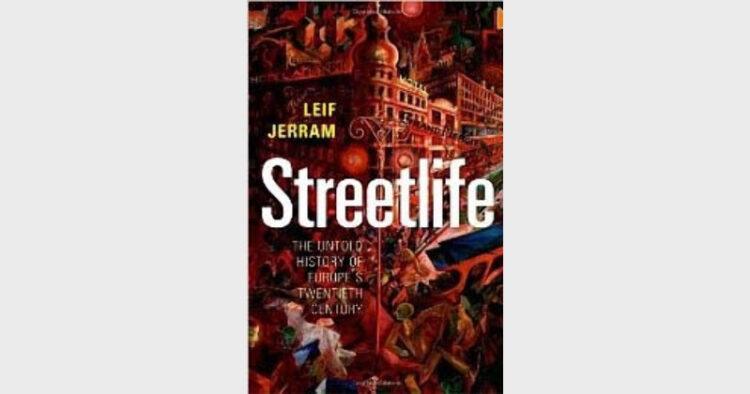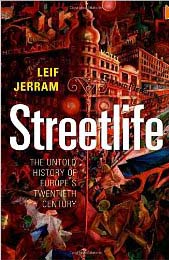Europe: How its streetlife influenced history?
By Dr Vaidehi Nathan?
Streetlife: The Untold History of Europe’s Twentieth Century, Leif Jerram, Oxford University Press, Pp 477 (HB), £18.99?
the cities in Europe shaped the events in the twentieth century and influenced the course of its history. What we see as modern and crowded and homogenous city streets today used to teem with a population that was drawn from all corners of the globe, where cultures and societies lived together, sometimes sparring but mostly in harmony. While accounts of historic events and personalities have been written in reams, the history of streetlife has been paid little attention to. That in nutshell is the case of Leif Jerram in his thought-provoking book Streetlife: The Untold History of Europe’s Twentieth Century.
Life then was less complicated, more open and there was a lot of sharing. But the phenomena of ‘planned’ city changed the way people lived, loved and worked. Jerram looks at the political, gender (female), cultural, sexual and lifestyle changes that happened in the still urbanising Europe. He discusses how the political ideologies were born in the streets of the city and the way women came out of their domestic confinement, fought for space in urban areas and struggled to retain ‘respectability.’ The ‘culture’ changed, with action moving from music halls to cinema, from cafes to concert halls and sports as a separate organised genre emerged. The planned homes also saw the separation of “sexual and emotional lives of children from their parents, and of children from each other.” The concept of restricted individual space, notions of privacy and solitude emerged to play a significant role in an individual’s life.
Some of the interesting developments are regarding culture, or rather performing arts. The music halls in the mid 1800s were popular places. The audience, near hundred per cent men, went about ‘milling, cruising, laughing and socialising.’ “The ‘culture’ of music hall was a ‘culture’ of integrated socialibility and sexuality, not one of passive spectatorship and separation.” But things changed with the introduction of limelight, a technique that revolutionised entertainment. This technique involved blasting a flame of highly inflammable oxygen-hydrogen gas onto a block of calcium oxide to produce intense heat and light of very clear whiteness. Using this, now the theatre and music hall owners could focus the attention on the performer, by following this light on them. Thus was born the segregation of the artist and the distant audience. By getting rid of tables and chairs, the owners could now get more people into the hall and earn money from the performance itself rather than from the food and drink served during its course. Thus, “Culture was separated from its consumers; its consumers were separated from each other.”
The other revolution Europe witnessed around 1900 was the emergence of sports, especially football. Till then games whether cricket or hunting were indulged in only by the rich as only they could afford the time and the equipment. But football got a set of formal rules and shape with the emergence of teams in the cities. “Crucially, by 1900, stadia were being constructed in Britain — at Crystal Palace, in London, and throughout the industrial cities of the north. By the 1920s, stadia were being constructed in other European cities specifically for the playing of football.”
Jerram discusses ‘planning’ elaborately. He says “Planning is also the self-same logic that underpins the holocaust and the Ukrainian famine in the 1930s and 1940s, the Great Leap Forward, the Cultural Revolution, and the Khmer Rouge in the 1960s an 1970s, and the European Union’s calamitous Common Agricultural Policy right up to the present day.” Planning he says hands over too much power to the states to ‘organise’ the lives of the citizens, stripping them of their individual space, creativity and most importantly instinct. “Planning is the twentieth century’s triumph and tragedy, the poison and antidote mixed together. Planning as a way of thinking and behaving, represents the paradox of progress and the genius of the twentieth century.” It is not as though there was no planning in ancient civilisations, he argues, adding the architecture bears witness to the order that prevailed. But that was only governments facilitating and not controlling or thinking for the individual.
Around the globe today, except in probably parts of Africa and parts of Asia, a majority of humans live in urban areas. In Europe now cities account for 80 per cent of living environments. In Britain it is as high as 90 percent and in Russia 75 per cent. This makes streetlife an important area of study and focus. Jerram argues that nationalities living in urban spaces do so in great harmony. Communities still hold on to their values and cultures. Despite the increasing drone of anti-city campaigning, urban areas continue to be confluences of human groups, communities, languages and cultures. “We have much to be proud of about ourselves and our cities: they are far more impressive for their social cohesion than their division, for their rich patchworks of communities and networks than for their loneliness and alienation, for their health than their sickness, for their wealth than their poverty, and for their tolerance and liberality than for their ethnic conflict and confrontation.”
Jerram’s arguments are compelling and more often than not agreeable. The movement of people to the urban areas during and following the industrial revolution in the west and the wars is a unique phenomenon. It is not witnessed in Asia, especially countries like India, where the majority of population continues to live in what is loosely called the rural areas. Most urbanites nurture dreams of going ‘home‘and work towards it. That is not the case in the West. Life and people there are more or less ‘identified’ with the urbane, modern, the planned and the sophisticated. This is evident from the literature, TV shows and the movies that emerge from there. Jerram’s narrative is both engaging and challenging to the mind. Jerram is Lecturer in Urban History in the School of Arts at Manchester University and has published widely in the field of cultural and urban history.
(Oxford University Press, Great Clarendon Street, Oxford ox2 6DP)?














Comments